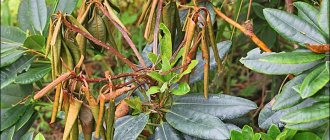In its natural environment, the fig is a spreading tree that has a powerful trunk and delicious, tender fruits that ripen in 3 stages. The tree has this appearance if it grows in the territory of Crimea and Abkhazia. In Kuban and Ukraine, the fig is a bush or compact tree that requires the formation of a crown and reliable shelter in winter. The plant in central Russia has the same appearance.
Necessary conditions for successful cultivation of figs
Figs are a very heat-loving subtropical crop with a long growing season (200-220 days), which requires a lot of heat for normal fruiting (fruit ripening and shoot ripening). Namely, the CAT-sum of active temperatures (the sum of average daily air temperatures exceeding +10 degrees) should be equal to 3500-4000 degrees .
In other words, the SAT (sum of active temperatures) of your area should allow the crop and wood (shoots) to ripen.
Accordingly, you will hardly be able to get a full harvest in the conditions of the Middle Zone (Moscow region), when grown in open ground, where the average SAT is 2000-2500 degrees.
Therefore, in the middle zone , in order to get a more or less good harvest, it is better to plant and grow figs in a trench, greenhouse or greenhouse .
The Rostov region and eastern Ukraine are much more suitable for growing figs (SAT - 3000 degrees or more).
Of course, figs can be grown with great success in the same Stavropol Territory, in the Kuban (Krasnodar Territory), in southern Ukraine, in the Crimea, where SAT is exactly 3500 degrees or more. Moreover, the most ideal conditions are the southern coast of Crimea and the Black Sea coast of Kuban.
Interesting! Figs can produce two harvests per season: the first (on last year’s shoots) in the summer (larger), the second (on new shoots) in the fall.
However, this is the case under normal growing conditions and proper shelter; in the conditions of the Middle Zone, you will only be able to ripen one crop.
Advice! If the second harvest does not have time to ripen, then the figs can be covered along with their pea-shaped fruits. Next year this will be your first harvest.
When do figs begin to bear fruit?
As a rule, already in the second year after planting.
Can I grow it in a pot at home?
Figs can be grown as a pot crop. You just need pots of sufficient capacity (at least 10 liters), almost any substrate (ordinary garden soil will do) and the ability to give the fig a dormant period in winter (after it sheds its leaves in November). Namely, keep it for 3 months (from December to February) in a cool place - a cellar or basement.
As for the growing conditions, as already mentioned, figs are heat- and light-loving, so they must be placed on a southern windowsill. It also adapts well to dry room air.
Video: how to grow figs at home
Diseases and pests
Based on where figs grow, you need to be prepared for the fact that the plant will be susceptible to various diseases and be attacked by pests.
The most common diseases are the following:
- Branch cancer, which covers the affected area of the trunk with cracks. As a result of the disease, the wood is exposed and part of it dies.
- Gray rot manifests itself as a gray and white coating on the fruits themselves.
- Fusarium leads to internal rotting of the fruit and peeling of the pulp.
- Anthracnose is characterized by the appearance of dark spots on fruits, which lead to rotting of the fruit.
- Fruit souring begins with the appearance of various brown or watery spots.
Branch cancer Gray rot Fusarium Anthracnose Fruit souring
When to plant figs in spring and autumn: optimal timing
Figs can be planted in both autumn and spring.
- If you decide to plant figs in the fall , then this should be done 3-4 weeks before the onset of frost, i.e. around September-October.
- If in spring , then after spring return frosts, i.e. not earlier than May in the middle zone and April in the southern regions.
As for when it is better to plant - in spring or autumn, most gardeners are still inclined to believe that it is better to plant figs in the spring, so that during the season it has time to take root well and adapt to the new place, because. during autumn planting, a young seedling may simply freeze (even under good cover) or dry out (due to improper cover).
How to save a seedling in winter if you bought it in the fall
If you purchased a seedling in the fall, or grew it from a cutting, but decided to postpone planting until spring, then you can save the seedling in one of the following ways:
- If you bought a seedling with an open root, then you need to plant it in a bucket (pot) and bring it to a cool place for wintering - in a basement or cellar, where the temperature in winter does not drop below zero (plus).
- If you have grown a seedling from a cutting, then in the fall it is advisable to dig it up with a large lump of earth and also place it in a basement or cellar for wintering.
Of course, you can try digging it in with earth or covering it in trenches (depending on your planting method).
SELF-FRUITING VARIETIES
Of course, the gall wasp is a unique insect, but since it does not live everywhere, breeders got down to business and now a gigantic number of self-fertile varieties of figs have been bred: Dalmatsky, Nikitsky, Abkhazian Violet, Crimean Black, Kadota, Brunswick, Shuisky, Gray Early, Sary Apsheronsky , Adriatic purple, Sochi No. 7, Randino, Pomorie, July, Lardaro, Gift for the 50th anniversary of October, Brown Turkey.
The most delicious of them all is the Dalmatian fig. It tolerates temperatures down to -15° C and bears fruit well only when it has built up a decent supply of wood. The best harvest is produced by 3-4 year old shoots. The weight of the fruits is on average 150-200 g. They are asymmetrical, greenish-yellow in color.
Brown Turkey figs are the most winter-hardy of all varieties. Withstands short-term temperature drops down to -20° C. Very productive, bears regular pear-shaped fruits weighing 100 g, red-brown in color.
Crimean black fig produces oval, ribbed purple fruits. They weigh about 100 g.
Rules for planting figs
Variety selection
Parameters of a suitable fig variety for growing in temperate latitudes:
- early or mid-early ripening;
- self-fertile (parthenocarpic);
Parthenocarpic = does not require pollination.
In general, figs are a dioecious plant in which male inflorescences grow on some trees and female flowers on others.
- remontant (fruiting twice - in summer and autumn);
- frost-resistant (maximum zoned).
For example, Brunswick is such a variety.
Place on site
Figs are a very warm and light-loving plant, in other words, an exclusively sunny place in your garden will suit it. In this case, the place must be protected from strong northeast winds.
In a shaded place, figs simply will not be able to grow normally, let alone bear fruit (fruits will hardly form, and those that do form simply will not have time to ripen).
Preparing the planting hole
As for the size of the planting hole for figs, it should be quite large. As a rule, a hole 40 cm deep and approximately the same width (diameter) will be enough, maybe a little more - 50-60 cm.
However! If you are going to plant figs in a trench (hole), then in this case you will have to dig a much deeper hole, at least 60-70 cm.
Figs are considered a crop that is not at all demanding on the soil composition (it can grow anywhere). But still, it is better to fill the planting hole (for speedy rooting) with sufficiently loose and fertile soil, and also add fertilizer (optional).
Thus, the planting hole can be filled with the following soil mixture:
- humus or compost (1-2 buckets);
- deoxidized peat (1-2 bucket);
- the top fertile layer of soil (which you still have after digging a hole);
Also, if desired, you can add phosphorus ( superphosphate or bone meal) and potassium fertilizers (potassium sulfate or wood ash ).
mix everything thoroughly , and then pour a small cushion (5 cm layer) of fertile soil (without fertilizers) and compact it .
You should have fertile soil left (garden soil + humus or compost + peat) for further filling of the seedling.
Preparing a seedling for planting
If you purchased a seedling with an open root system (OKS) , then immediately before planting it in the ground, it is advisable to first renew (slightly trim) the tips of its roots , and then dip them in a clay mash (for better contact with the ground).
As for preparing a seedling in a pot (with a closed root system) , it is practically not required. However, often after planting, fig leaves begin to turn yellow and white, resulting in sunburn. The fact is that before planting a seedling in open ground, it is advisable to harden it in order to accustom the seedling to direct sunlight .
Therefore, begin to gradually take the pot with the seedling out into the fresh air during the day (into the garden or onto an open balcony), gradually increasing the time spent there. Typically, adaptation will take about 2-3 weeks.
Methods for planting fig seedlings
In a permanent location, seedlings can be planted in open ground (straight or inclined), in a hole or trench, or in a pot (for further growing indoors).
By the way! As for the planting scheme: if you are planting several seedlings, then the distance between the bushes should be at least 3-3.5 meters .
Landing in the ground
- Prepare and fill the planting hole with fertile soil mixture.
- Place a mound in the center (if you are planting a seedling with an open root system).
If you plant a seedling in a container, then you need to plant it on a flat surface.
- Plant a seedling. Place it on a mound and spread the roots down (in no case should they look up).
- As for the planting depth, it is advisable that the seedling be planted below ground level (in a hole). Only in this case will you be able to cover it most reliably for the winter, and the root system of the young seedling will definitely not freeze out.
However! You can try planting the seedling flush with the soil surface.
- Next, you need to fill the seedling with fertile garden soil and then compact it.
- Water abundantly (2-3 buckets). Wait until the moisture is absorbed. If the ground settles too much, add more soil.
- As a rule, immediately after planting you need to prune the figs (for more information on how to shape a young seedling, read the separate paragraph “Formation”).
Video: planting figs in spring
Inclined landing in the ground
It is not necessary to plant directly; you can plant the seedling obliquely (at an angle of 45 degrees, like currants); this way, in the future, you will simplify the task of bending and covering the branches for the winter.
At the same time, some summer residents advise burying the seedling below the root collar by 10-15 cm, i.e. so that there are 2-3 buds in the ground.
Landing in a hole (trench)
To ensure that figs do not freeze in winter, it is optimal to plant them in a hole (trench).
By the way! It is much better if there is also a greenhouse (greenhouse) above the trench.
Why is it ideally preferable to grow figs in the middle zone in a hole?
The fact is that it is much easier to cover and bend the shoots this way. In fact, the bushes will be located in the basement, where the temperature will definitely not drop too low (provided there is proper dry shelter) and the shoots will not freeze. Thus, this will guarantee that unfrozen ground will save you from freezing temperatures.
What dimensions should a suitable trench have?
A depth of at least 30, and preferably 50-60 centimeters, a width of 50-60 and a length of 2-3 meters.
For more information about the nuances of planting and growing figs in a trench (pit), see the video below.
Video: growing figs in a hole
How to care for figs in open ground
In fact, figs require minimal care - mainly just watering and proper shelter for the winter.
Make sure that the bush is not too thick, then all branches and fruits will receive enough sunlight.
So, if you planted a fig seedling in the spring, then you will need to water it regularly (every week), as well as loosen and weed the tree trunk from weeds, and in the fall, properly cover it for the winter.
If you planted it in the fall, then just monitor the humidity (if the autumn is dry, water it a couple of times) and be sure to cover it thoroughly.
Watering
Despite the fact that figs are considered a drought-resistant plant, they require moderate moisture supply, in other words, watering is one of the main agrotechnical measures for its cultivation.
The fact is that the root system of figs, most of it, is located in the upper layers of the soil (at a depth of up to 40 cm), and its drying out can lead to negative consequences: the leaves will begin to turn yellow and fall off, and the fruits will not ripen.
Therefore, during the generally dry summer months, figs should be watered periodically (at least 1-2 times a month).
That is why they begin to water figs in May and stop in July-August, when the fruits fill and ripen.
If there is a lack of moisture, the yield is slightly reduced, and if there is too much, the fruits lose their sweetness and begin to quickly deteriorate and turn sour.
Shaping and trimming
Immediately after planting, as a rule, figs need to be trimmed and shaped.
To make it convenient to cover the fig for the winter, it is best to form it in the form of a bush (i.e. use a bush formation ).
In warm southern regions (on the Black Sea coast), of course, you can grow figs in the form of a tree.
So, if you decide to form a fig in the form of a bush, then immediately after planting it needs to be cut at a height of 10-15 cm from the soil surface, leaving 3-4 buds, which will later become the main skeletal branches of the bush and fruit-bearing shoots will grow on them.
Advice! It is very convenient to grow figs in the form of a horizontal cardoon , i.e. pruning (shaping) like grapes .
The creeping shape of figs can be created in another way. Namely, initially cut to 25-30 cm, then, after new shoots form from the buds, leave only the lowest ones and immediately bend them to the ground in different directions. Cut off the upper part of the trunk completely and cover it with garden varnish. As a result, the bush forms a spider-like shape.
In addition, do not forget about sanitary and thinning pruning. Namely, remove damaged, dry, weak and excess branches (make sure that the bushes do not thicken).
Note! Figs bear fruit on the shoots of the previous and current year, so they need annual pruning, just like grapes.
As for the timing , annual pruning of figs is carried out in the fall (before covering) and/or in the spring (before the start of sap flow) . In this case, it is advisable to cover the cut areas with garden varnish, since they do not overgrow well and the entire branch may dry out.
Growing season: summer
Growing and caring for plants depends on the shape of the bush. The choice of formation depends on the latitude of the area. In the southern regions, a high formation is applicable, in the temperate zone - low, in cold regions - a horizontal cordon.
At the beginning of June, the temporary shelter is removed. Plants planted in April are already well rooted and an active growth period is beginning. Caring for figs in the summer consists of abundant watering, fertilizing, pruning shoots and planting the tree trunk.
Preparing figs for winter: autumn pruning and shelter
This is perhaps the most important component of successfully growing figs.
Therefore, we invite you to read a separate article that describes the basic rules for autumn care and proper preparation of figs for winter .
Of course, in the spring it is necessary to open the fig bushes in a timely manner (as a rule, they are fully opened only after the threat of frost has passed)
Well, figs can indeed be grown even in mid-latitudes. It will be quite difficult to do this, but it is quite possible, especially in a trench, greenhouse or greenhouse. If you do everything correctly, then figs will definitely respond to your care not only with their decorative beauty, but also with magnificent fruits.
Video: features of planting, care and propagation of figs











